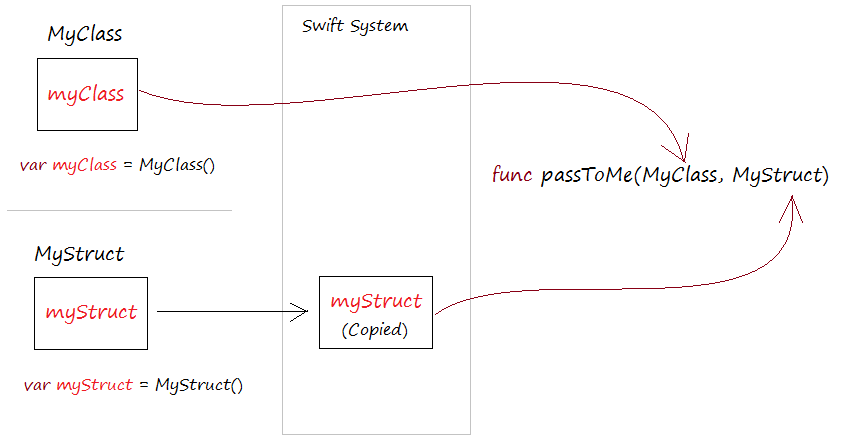Swift Structs Tutorial with Examples
1. What is Struct?
No ADS
In Swift, Struct (structure) is a special type of value, it creates a variable, to store multiple values, but the values are related to each other.
For example, information about an employee include:
- Employee number
- Employee name
- Position
You can create 3 variables to store the information above of employee. However you can create a Struct to store all three information on in a single variable.
Swift uses struct keyword to declare a Struct.
Employee.swift
import Foundation
struct Employee {
var empNumber:String
var empName:String
var position:String
// Constructor.
init(empNumber:String, empName:String, position:String) {
self.empNumber = empNumber;
self.empName = empName;
self.position = position;
}
}For example, use Struct:
EmployeeTest.swift
import Foundation
func test_EmployeeStruct() {
// Create a variable from Employee struct
let john = Employee(empNumber:"E01",empName: "John",position: "CLERK")
print("Emp Number: " + john.empNumber)
print("Emp Name: " + john.empName)
print("Emp Position: " + john.position)
}Edit main.swift:
main.swift
import Foundation
test_EmployeeStruct()Running the example:
Emp Number: E01
Emp Name: John
Emp Position: CLECK2. Struct vs Class
No ADS
Struct is commonly used to create an object to store the value, while the class is using more diversely.
- Struct does not allow inheritance from a class or another struct.
- But Struct allows inheritance from one or more Protocol.
If struct appears as a parameter in a function (or method), it is passed as a value. Meanwhile, if the instance of a class appears as a parameter in a function (or method) it is passed as a reference.

StructVsClass.swift
import Foundation
// A class
class MyClass {
var name: String = "Abc"
}
// A struct
struct MyStruct {
var name: String = "Abc"
}
// A function, 2 parameters
// First parameter is a class, and second parameter is a struct.
func passToMe( myClass: MyClass, myStruct: MyStruct) {
// Change value to 'name' field.
myClass.name = "New Name"
// Can not change value to field of this struct.
// (It is a copy,its fields become constants and can not be changed.
// myStruct.name = "New Name" ***
}
func test_passToMe() {
// An object of MyClass.
var mc = MyClass()
print("mc.name = \(mc.name)") // Abc
// A value of MyStruct.
var ms = MyStruct()
print("Call passToMe function")
// Pass to passToMe() function.
// Note: The first parameter does not require a Label.
passToMe( mc, myStruct: ms)
print("mc.name = \(mc.name)") // New Name
}Running the example:
mc.name = Abc
Call passToMe function
mc.name = New Name3. Constructor of Struct
Struct can have Constructors but do not have Destructor
Here are few notes for the Constructor:
- You can write one or more constructor for struct.
- In the constructor you must assign values to all fields that don't have value.

4. Methods and properties of Struct
No ADS
Struct can have methods and properties.
Book.swift
import Foundation
struct Book {
// Property
var title:String {
get {
return self.title;
}
set (value) {
self.title = value
}
}
// Property
var author:String {
get {
return self.author;
}
set(value) {
self.author = value;
}
}
// Constructor.
init( title:String, author:String) {
self.title = title;
self.author = author;
}
// Method.
func getInfo() -> String {
return "Book Title: " + self.title + ", Author: " + self.author;
}
}See more about properties at:
- Swift Properties
No ADS
Swift Programming Tutorials
- Install Mac OS X 10.11 El Capitan in VMWare
- Install XCode
- Swift Tutorial for Beginners
- Swift Functions Tutorial with Examples
- Swift Closures Tutorial with Examples
- Class and Object in Swift
- Swift Enums Tutorial with Examples
- Swift Structs Tutorial with Examples
- Programming for Team using XCode and SVN
Show More